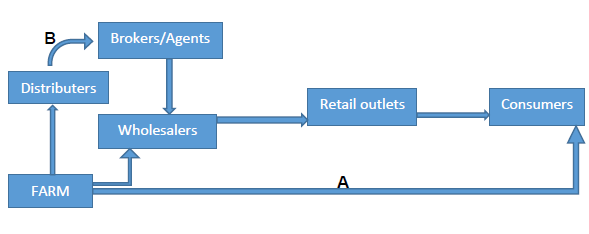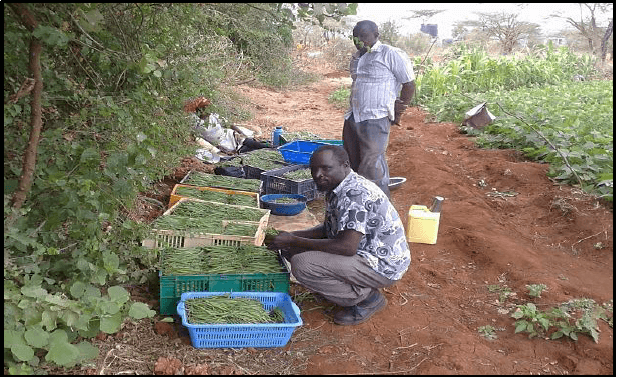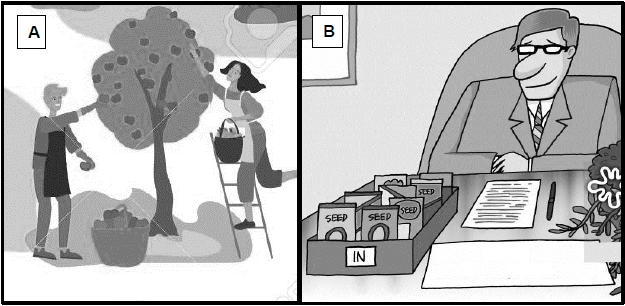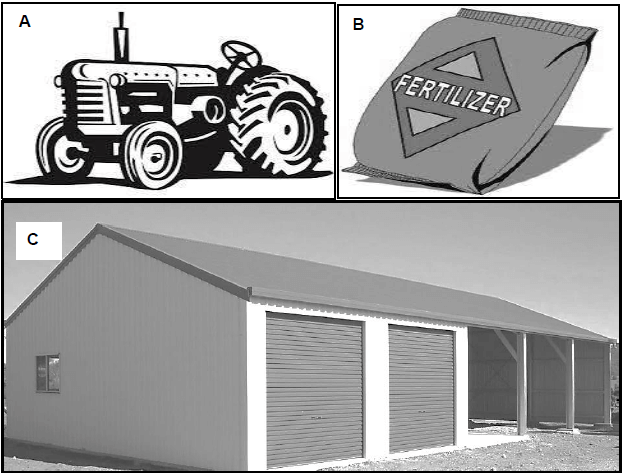Agricultural Sciences Paper 2 Grade 12 Questions - NSC Past Papers And Memos September 2020 Preparatory Examinations
Share via Whatsapp Join our WhatsApp Group Join our Telegram GroupINSTRUCTIONS AND INFORMATION
- This question paper consists of TWO sections, namely SECTION A and SECTION B.
- Answer ALL the questions in the ANSWER BOOK.
- Start EACH question on a NEW page.
- Number the answers correctly according to the numbering system used in this question paper.
- You may use a non-programmable calculator.
- Show ALL calculations, including formulae, where applicable.
- Write neatly and legibly.
QUESTIONS
SECTION A
QUESTION 1
1.1 Various options are provided as possible answers to the following questions. Choose the answer and write only the letter (A–D) next to the question numbers (1.1.1–1.1.10) in the ANSWER BOOK, for example 1.1.11 D.
1.1.1 This Act aims to increase market access for all participants:
- Meat Safety Act
- Consumer Protection Act
- Marketing of Agricultural Products Act
- oodstuffs, Cosmetics and Disinfectants Act
1.1.2 ... is found on the demand side of an agribusiness value chain.
- Service
- Manufacturing
- Processing
- Research of new cultivars
1.1.3 The following are reasons why agricultural products are price inelastic in terms of supply:
- Long production period
- Most agricultural products are perishable
- Availability of substitutes
- Harvesting and marketing of agricultural produce is seasonal
Choose the CORRECT combination:
- (i), (ii) and (iii)
- (i), (iii) and (iv)
- (i), (ii) and (iv)
- (ii), (iii) and (iv)
1.1.4 Price fixing occurs in a …
- monopoly.
- free market.
- monopsony.
- controlled market.
Choose the CORRECT combination:
- (i), (ii) and (iii)
- (i), (iii) and (iv)
- (i), (ii) and (iv)
- (ii), (iii) and (iv)
1.1.5 A farmer’s total income after selling tomatoes is R20 000. The farmer incurred R34 500 in production and marketing costs. The
farmer therefore has made … .
- a profit of R14 500.
- a profit of R54 500.
- a loss of -R14 500.
- a loss of R14 500.
1.1.6 Which ONE of the following is NOT an example of a production risk?
- Availability of capital
- Technology
- Pests and diseases
- Machinery efficiency
1.1.7 The following are economic functions of land except that …
- land can be used as collateral.
- land can be bought or sold.
- land is a source of minerals.
- land provides space for agricultural activities.
1.1.8 … is a method of crop improvement in which individual plants are selected on the basis of phenotype from a mixed population, their seeds are bulked and used to grow the next generation.
- Family selection
- Pedigree selection
- Mass selection
- Progeny selection
1.1.9 Which ONE of the following applies ONLY to a dihybrid cross?
- Law of segregation
- Law of independent assortment
- Dominance
- Fertilisation
1.1.10 ONE of the following is NOT an advantage of genetic engineering over traditional methods:
- Precision
- Not limited to individuals of the same species
- Results are obtained within a relatively short space of time
- Requires fewer skills and experience (10 x 2) (20)
1.2 Choose a term/phrase from COLUMN B that matches a description in COLUMN A. Write only the letter (A–J) next to question numbers (1.2.1–1.2.5) in the ANSWER BOOK, for example 1.2.6 K.
COLUMN A | COLUMN B | ||
1.2.1 | Marking products with a distinctive label so that consumers know their manufacturer conforms to recognised environmental standards | A | heredity |
1.2.2 | A management strategy in which the cost of the consequences of a risk is distributed among several stakeholders | B | budget |
1.2.3 | A complete list of assets on a farm | C | inventory |
1.2.4 | The passing on of characteristics from one generation to the next | D | green marketing |
1.2.5 | The study of heredity and the variation of inherited characteristics | E | eco-labelling |
F | risk sharing | ||
G | diversification | ||
H | genetics | ||
(5 x 2) (10)
1.3 Give ONE word/term for each of the following descriptions. Write ONLY the word/term next to the question numbers (1.3.1–1.3.5) in the ANSWER BOOK.
1.3.1 When the demand for a product at a specific price is equal to the supply of that product at the same specific price
1.3.2 People who recognise business opportunities and are willing to take the risk of starting their own business
1.3.3 The process of identifying, assessing and managing uncertainties or scenarios that could affect an organisation’s ability to achieve its long- term objectives
1.3.4 Output per unit labour input
1.3.5 A trait associated with a gene that is carried only by the male or female parent (5 x 2) (10)
1.4 Change the UNDERLINED WORD(S) in each of the following statements to make them TRUE. Write only the answer next to the question numbers in the ANSWER BOOK.
1.4.1 Supply is the quantity of goods consumers are prepared to buy at a given price.
1.4.2 A whole farm budget provides an overview of cash inflow and outflow during a specified period of time.
1.4.3 A locus refers to one of the alternative forms of a gene.
1.4.4 Heterosis is the reduced biological fitness in a given population as a result of inbreeding.
1.4.5 A vector is an agent, such as radiation or a chemical substance, which causes genetic mutation. (5 x 1) (5)
TOTAL SECTION A: 45
SECTION B
QUESTION 2: AGRICULTURAL MANAGEMENT AND MARKETING
Start this question on a NEW page.
2.1 The graph below shows one of the price-determining factors.
2.1.1 Identify the price-determining factor represented by the curve above. (1)
2.1.2 Briefly explain how each of the following factors below will make the curve to shift in the direction shown by the arrow:
- Technology (2)
- Environmental conditions (2)
2.1.3 Give TWO factors, in addition to those given in QUESTION 2.1.2, that would influence the shape of the curve above.(2)
2.2
2.2.1 Name the process shown by the flow diagram above. (1)
2.2.2 Identify the marketing channels shown by the arrows A and B. (2)
2.2.3 Give ONE advantage of marketing channel A to the consumer. (1)
2.2.4 Suggest methods which can be used to deal with each of the challenges below that could hamper the process mentioned in QUESTION 2.2.1:
- Distance to markets (1)
- Perishability of produce (1)
2.2.5 Describe how each of the following factors affects the process above:
- Low volume in relation to size (1)
- Seasonality of production (2)
2.3 The statements below describe various approaches which can be used by farmers to market their produce.
- The business of promoting and selling a product or service to a specialised segment of a market.
- A market strategy in which a farmer decides to ignore market segment differences and appeal to the whole market with one offer or one strategy.
- A marketing strategy where a company tries to gain customers from more than one type of market for the same product and uses.
2.3.1 Identify the marketing approaches A–C. (3)
2.3.2 Identify a marketing approach in which prices are likely to be high. (1)
2.3.3 Give TWO reasons to support your answer. (2)
2.3.4 Suggest TWO methods of promoting products that are suitable for marketing approach B. (2)
2.4 The photograph below shows two of a group of farmers who are marketing their produce collectively.
[Extracted from google.com]
2.4.1 Name the marketing system depicted above. (1)
2.4.2 Suggest TWO principles that govern the association of the farmers above. (2)
2.4.3 Give TWO benefits derived by the farmers from the marketing system they chose. (2)
2.4.4 State the name of a key document the farmers above will have to prepare so as to acquire funding to grow their business. (1)
2.4.5 List TWO components of such a document. (2)
2.5 An organisation has the following attributes.
- A neighbouring farmer producing similar produce has gone bankrupt.
- The farm has a highly qualified and experienced farm manager.
- The farm has negative net worth.
Deduce whether each of the attributes A–C given above represents a strength, weakness, opportunity or threat to the business. (3)
[35]
QUESTION 3: PRODUCTION FACTORS
Start this question on a NEW page.
3.1
| Land is an area of ground, especially one that is used for a particular purpose such as farming or building. |
3.1.1 Explain the meaning of each of the following economic characteristics of land:
- Urban development (1)
- Land is limited (1)
- Land is subject to the law of diminishing returns (2)
3.1.2 A farmer observed that farm yields on his farm have been declining for the past three years. Suggest THREE methods this farmer can use to improve
the productivity of his land. (3)
3.2 The illustrations below shows two types of labour found on farms.
3.2.1 Deduce the type of farm workers represented by images A and B above. (2)
3.2.2 Motivate your answers to QUESTION 3.2.1 above. (2)
3.2.3
- Identify the farm worker that is most likely to be exploited by the employer. (1)
- Justify your answer to QUESTION 3.2.3 (a) above. (1)
3.2.4 Name a piece of legislation that protects farm worker A from exploitation. (1)
3.3 Below are aspects of either an enterprise or a whole farm budget.
| overhead costs; variable costs; net profit; gross margin |
3.3.1 Use the terms in the table above to differentiate an enterprise budget from the whole farm budget. Write only the correct term next to the letters A–D. (4)
ENTERPRISE BUDGET | WHOLE FARM BUDGET | |
Type of costs | A | B |
Type of returns | C | D |
3.3.2 Justify the use of enterprise budgets in farm business management. (2)
3.4 The diagrams below show various types of capital.
3.4.1 Deduce the types of capital represented by the images A–C above. (3)
3.4.2 Give the letter of the capital item which is funded using medium term credit. (1)
3.4.3 Describe TWO problems that are associated with capital. (2)
3.4.4 Suggest TWO methods farmers use to create capital. (2)
3.5 Read the scenario below and answer the questions which follow.
| A farm manager drafts budgets and prepares production plans. The manager then decides which activities are going to be done by who, when and how. During various production activities the manager monitors progress and ensures that everything is done as planned. The manager finally takes time to evaluate his/her decision-making. |
3.5.1 Deduce THREE main management principles described in the passage above. (3)
3.5.2 Identify TWO management skills that the manager above possesses. (2)
3.5.3 Motivate your answer to QUESTION 3.5.2. (2)
[35]
QUESTION 4: BASIC AGRICULTURAL GENETICS
Start this question on a NEW page.
4.1
| In goats, brown coat colour (AA), is dominant over black coat colour (aa). However, a separate gene (C) is necessary for pigment production. A goat with a recessive c allele at this locus is unable to produce pigment and is albino regardless of the allele present at locus A. |
4.1.1 Identify the mechanism of inheritance described in the passage above. (1)
4.1.2 Motivate your answer to QUESTION 4.1.2. (1)
4.1.3 Determine the phenotypes of animals with the following phenotypes:
- Aacc
- AaCc (2)
4.1.4 Determine the following if a ram with genotype AaCc is crossed with an ewe with genotype AaCc:
- Deduce TWO genotypes of the ram’s gametes (2)
- Determine the phenotypic ratio of the cross above (1)
4.2 A farmer crossed a black bull (Rr) with a white cow (rr).
4.2.1 Use a Punnet square to illustrate the cross above. (4)
4.2.2 Determine the phenotypic ratio of the offspring as a percentage. (2)
4.3
| Some years ago, cattle breeders observed that the Hereford was a better beef producer than the indigenous Afrikaner cattle. However, the Hereford was not adapted to South African conditions as it was less resistant to ticks and more susceptible to diseases such as heartwater. The breeders crossed Afrikaner cattle with Hereford to produce a new breed. |
4.3.1 Deduce an advantage of indigenous breeds over exotic breeds from the passage above. (1)
4.3.2 Identify the breeding method used by the breeders in the passage above. (1)
4.3.3 Give the name given to the products of the breeding system utilised above. (1)
4.3.4 Give TWO disadvantages of the breeding system described in the passage above. (2)
4.4
TRAIT | EBV (kg) | HERITABILITY (%) |
Birthweight | 2 | 40 |
Weaning weight | 10 | 65 |
Carcass weight | 15 | 70 |
Mature cow weight | 24 | 85 |
4.4.1 What does the acronym EBV stand for? (1)
4.4.2 Explain the meaning of the EBV figure for weaning weight. (2)
4.4.3 What conclusion can be drawn from a trait with a heritability of 85%? (2)
4.4.4 Name the type of variation shown by the traits in the table above. (1)
4.4.5 On the same axis, draw a bar graph to show the relationship between EBV and heritability. (6)
4.5
| Genetic engineering is not essential for all crop improvement. However, in some cases it helps to improve yields and nutritional value, and reduces the risks and costs associated with the overuse of fertilisers and pesticides. |
4.5.1 Deduce an environmental benefit of genetic engineering in the passage above. (1)
4.5.2 Explain how genetic engineering results in the benefit mentioned in QUESTION 4.5.1. (2)
4.5.3 Mention TWO social risks associated with the use of genetically modified seeds. (2)
[35]
TOTAL SECTION B: 105
GRAND TOTAL: 150